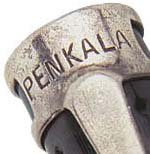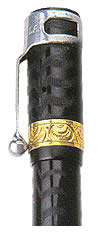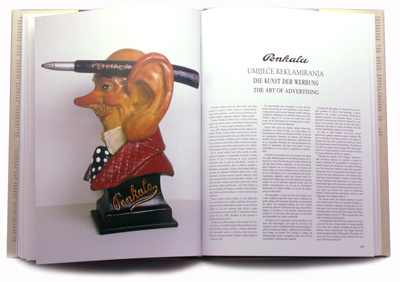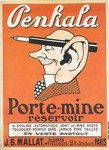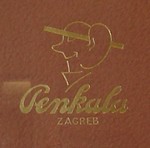Croatia - Slovakia
historical and cultural relations
Darko Zubrinic, 2009
Source: Dubrovnik
Literature written in Croatian flourished in Dubrovnik. In the first place we should mention Marin Drzic (1508-1567), who is one of the most outstanding names of the European Renaissance literature, a predecessor to Moliére's comedy and Shakespeare's drama (Moliére 1622-1673, Shakespeare 1564-1616). It was observed long ago that Marin Drzic handled themes and motifs that appeared 50 years later in the works of Shakespeare.
A few of Drzic's books printed in Venice in Croatian language have been discovered in Milano (MI0185 Biblioteca nazionale Braidense - Milano):
- Tirena comedia Marina Darxichia prikasana u Dubrouniku godiscta 1548. ukoioi ulasi Boi na nacin od morescke; i tanaz Na nacin pastirschi. In Vinegia (Venice): al segno del Pozzo 1547. [Andrea Arrivabene], 1551.
- Piesni Marina, Darxichia viedno staugliene s mnosim drusim liepim stuarmi. [Venezia : Niccolò Bascarini], 1551.
Also Shakespeare's The Tempest has its source in the old Croatian chronicle from the 12th century, known as the Chronicle of Father Dukljanin. Its Italian translation was published in 1601, a decade before The Tempest was composed (see [Mardesic], p. 151).
The importance of Drzic as a playwright for Croatians is analogous to that of Shakespeare for the English, Moliére for the French, and Goldoni for the Italians. Note that Shakespeare was three years old when Drzic died. Drzic's plays were translated into Chinese, Czech, Dutch, English, Esperanto, Finish, French, Italian, Japanese, German, Hungarian, Polish, Russian, Slovakian, Swahili, Swedish, and some other languages.
Source: Croatian Science
Eduard (Slavoljub) Penkala (1871-1922), born in Slovakia to a Polish/Dutch family, became naturalized Croat when after his marriage his family immigrated to Zagreb. He invented the mechanical pen in 1906 and fountain pen in 1907 which are bearing his name and now they are in everyday use.
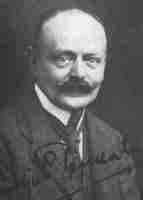

His first invention was a rasin bottle filled with hot water, called Termofor (hot water bottle), used in bed as "central heating" during cold nights.
Penkala invented a new plastic mass substance called ebonite, and used it for production of gramopne records. He then signed a contract with the Edison-Bell company, England, and a new company Edison-Bell-Penkala Ltd. was founded in Zagreb which started the production of gramophone records based on his original technology.
The Penkala factory in Zagreb in 1912, Branimirova street, had about 300 employees, with canteen, kindergaten, swimming pool, and even a football club Penkala. It was among largest factories for office equipment in the world.
Soruce: Croatian Latinists
The court of the king Mathias Korvin was a strong European humanistic center, to which the Croats gave a deep imprint. Thus the tutor of Mathias Korvin was Ivan Vitez (1405-1472), a Croatian Latinist, who also had the merit to open the University of Bratislava (capital of Slovakia) and the Academy and library of Budim (part of today's Budapest). He was a cardinal and occupied the position of the king's chancellor. In his speech in Vienna he asked for help to stop the penetration of the Turkish Ottoman Empire to Croatian lands.
A Croatian Jesuit Nikola Plantic (born in Zagreb, 1720-1777) studied in Zagreb, Graz, Vienna and Trnava in Slovakia. He was teaching logic and philosophy at the Jesuit University in Cordoba in Argentina.
Another Turkish captive was Juraj Hus (Hosti), contemporary of the above mentioned Bartol Gyurgieuvits. After the defeat of Sultan Suleyman the Magnificent in the battle with the army led by famous Croatian statesman Nikola Jurisic in 1533 (the aim of Suleyman was to occupy Vienna), and after his retreat through Croatian lands, Juraj Hus was taken to slavery from his village (Rasinje) to Constantinople. Since he did not want to renounce his Catholic faith, he managed somehow to be educated as a Turkish military trumpeter. As a musician he visited many lands: India, Egypt, and Holy Land. He described his visit to pyramids near Cairo, where he was playing his trumpet on the top of a pyramid, while soldiers below were measuring the volume of the pharaoh's grave. After many years he managed to escape, and reached Genova, and then Rome, where he was accepted in the Croatian Collegium of St. Jerome. In his village in Croatia he did not find any of his relatives, and died in Pozun (today's Bratislava in Slovakia) around 1566. He left the description of his pilgrims in his manuscript entitled Descriptio peregrinationis Georgii Huszthii. One version of the manuscript is held in the Vatican library, and the other in the National Library in Vienna. For more details see [Zoric].
Jakov Mikalja (Giacomo Micaglia, ~1600 - 1654) was lexicographer and theological writer born in Peschici in Italy in Molise (the name of Peschici is obviously of Croatian origin), collaborator of Bartol Kasic. He was descendant of Croatian exiles that had to escape before the Turks from Dalmatia. After his studies he lectured at the Jesuit collegium in Dubrovnik. His most important work is a dictionary Blago jezika slovinskoga containing 25,000 words (Thesaurus linguae Illyricae sive Dictionarium Illyricum, 1649, printed in Loreto and finished in Ancona in 1651), and also Croatian-Italian-Latin dictionary with grammar, containing rich vocabulary of Croatian ikavian - chakavian and stokavian words. In this huge book having 926 pages, which starts with Croatian column, he clearly stated to be Croat. His surname is derived from his father's name (son of Mikalj), so that Mikalja is genitive case of Mikalj. His book Ortografija jezika slovinskog represents the first printed orthography of Croatian language. He also published Bogoljubno razmisljanje od Ocenasa in Pozun (= Bratislava) in 1642. The only known copy of this book, printed in Croatian language, is held Bibliothéque Nationale in Paris (within section of Slovak literature!). It is interesting that Mikalja founded the first school for Croatian children in Temisoara in Romania.
Vladimir Horvat: Jubileji leksikografa Mikalje
In Loreto there is a Croatian collegium
founded in 1580.
Source: Stjepan Tomislav Poglajen or Tomislav Kolakovic

Stjepan Tomislav Poglajen or Tomislav Kolakovič in Slovakia; source [Komorkovsky]
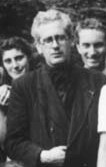
Poglajen's range of activities is indeed amazing in its global aspect: from Croatia, across Hungary, Slovakia and Czechia, to Russia, USA, China, Vietnam, India and Phillipines.
...
He was active as a preacher and minister, and his solid education in the field of medicine was quite important during the tragic days of the WWII. A Slovak politician declared in 2006 that collaborators of professor Kolaković had to pay with five hundred years of prison (see Cviić in [Šestak, p. 31]). "Professor Kolaković" was Poglajen's conspirative name in Slovakia, coined according to his mother's second name. Poglajen and members of Rodina were actively participating in anti-fascist movement in Slovakia.
Poglajen was persecuted by various secret police organizations,
equally Fascist, Nazist and Communist. He was a violent critic of all
three mentioned totalitarisms already in 1937, when he became editor in
chief of the important and influential journal Život (Life) in Zagreb,
issued by Croatian Jesuits. Upon the arrival of Nazists to Croatia he
had to escape from Zagreb to Split in 1941, and then to Slovakia in 1943.
...
Several attempts of his physical liquidation by the Russian secret service (see Milan Simčić in [Šestak, p. 34]) persuaded him to be extremely cautious, even in European West. Until the end of his life he lived under various pseudonyms. One of his pseudonyms in France was professeur Georges, abée Georges, or simply professeur in Belgium, profesor Kolakovič or Vlado or simply profesor in Slovakia, Father George in the USA and India, Houyang or professor Yoris in China, etc.
...
It is indeed amazing that Poglajen was planning his direct contact with Stalin, and even travelled to Moscow with that goal. Having encountered Soviet soldiers arriving in 1944 to Slovakia during the final operations against Nazists, he realized that many of them are deeply attached to the spirituality of Eastern Christianity. During his 6 month's travel through the USSR immediately after the WWII he learned about Catacomb Churches among Eastern Christians, both Pravoslav and Catholic (Milan Simcic in [Šestak, p. 35]), about which he reported in the book "God's Underground" prepared by Gretta Palmer in 1949.

Stjepan Tomislav Poglajen or Tomislav Kolakovič in Slovakia; source [Komorkovsky]

Stjepan Tomislav Poglajen or Tomislav Kolakovič in Slovakia; source [Komorkovsky]
Kolakovič T.: Božie podzemie, Sekulárny inštitút Fatima v Nitre, Slovakia, 1994.
Vaclav Vaško: Profesor Kolakovič - mýty a skutočnosť, Impulz, Slovakia, 2006.
JÁN KOMOROVSKÝ: Usporiadanie spoločnosti podľa Stjepana Tomislava Poglajena Kolakoviča (K 100. výročiu narodenia) [PDF], Viera a život, Slovakia, 2006, č. 4, 18-28.
Source: Croatian Art
In the fine arts of our time probably the most famous is the sculptor Ivan Mestrovic (1883-1962), who created masterpieces, many of which are dedicated to the history of his motherland. You can see them in the Mestrovic gallery in Split and in Croatian capital Zagreb. He also created
- the bust of Cardinal Alojzije Stepinac, New York (Croatia Place, Lackawanna),
- the grand ``Monument of the Unknown Soldier'' and ``The Monument of Gratitude to France'' in Belgrade,
- the beautiful Mausoleum of Petar Petrovic Njegos, Montenegrin poet and statesman (Lovcen in Montenegro),
- ``The Well of Life'' in Zagreb,
- ``History of the Croats'' (symbol of the University of Split), whose several copies are held in Croatia, while the original is in Belgrade (!), capital of the new Yugoslavia. He planned it to be situated in the "Museum of Croatian Antiquities" in Split. One expects the Serbs to return this important monument to Croatia.
 His
sculptures can be seen in London (Tate Gallery), Florence (in
"Uffizi"), Torino, Rome, Prague (in Hradcany), Budapest, Chicago (Chicago
Indians, Grand Central Park, see a postcard on the right from 1939
and two photos below), South Bend (Indiana, USA), Rochester (Minnesota,
USA), Baton Rouge (Louisiana, USA) etc. He also carved a monument of
the most outstanding Slovak writer Martin
Kukucin (Matej Bencur) in Punta Arens (Patagonia, Argentina). Matej
Bencur spent a part of his life in Croatia on the island of Brac and
wrote a book about the life of the Croatian emigrants in South America.
His
sculptures can be seen in London (Tate Gallery), Florence (in
"Uffizi"), Torino, Rome, Prague (in Hradcany), Budapest, Chicago (Chicago
Indians, Grand Central Park, see a postcard on the right from 1939
and two photos below), South Bend (Indiana, USA), Rochester (Minnesota,
USA), Baton Rouge (Louisiana, USA) etc. He also carved a monument of
the most outstanding Slovak writer Martin
Kukucin (Matej Bencur) in Punta Arens (Patagonia, Argentina). Matej
Bencur spent a part of his life in Croatia on the island of Brac and
wrote a book about the life of the Croatian emigrants in South America.

![]()

Mestrovic's Chicago Indians were cast in the city of
Zagreb, capital of Croatia
Ivana Brlic Mazuranic (1874-1938) is a very well known name among Croatian children. She wrote beautiful books of Croatian fairy tales, the most famous being Price iz davnine (Tales of Long Ago) that appeared in Zagreb in 1916. It was translated from Croatian into English by F.S. Copeland under the title:
|
Croatian Tales of Long Ago
by Iv. Berlic Mazuranic |
and published in 1924. in London by George Alen & Unwin Ltd (260 pp, hardcover).
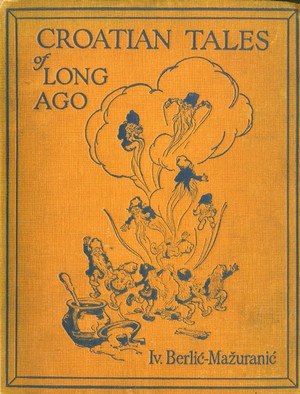

For more photos see Yale University Library
These stories have become popular worldwide due to recent fantastic flash-art presentations, initiated by Helena Bulaja, Zagreb. See for example Neva, music and animation by Ed Beals.
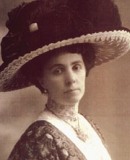
Books of Ivana Brlic Mazuranic were translated into all major world languages (more information in Croatian). Except in English, there exist also translations into
- Swedish (Stockholm, 1928)
- Danish (Kopenhagen, 1929/30)
- Czech (Prague, 1930)
- Russian (Zagreb [!], Skazki davnyago vremeni, 1930)
- Slovakian (T. sv. Martin, 1931)
- German (Salzburg, 1933)
- ...
- Chinese (1957)
Croatian Tales of Long Ago by Ivana Brlić Mažuranić in Slovakian translation.
Apprentice Hlapić by Ivana Brlić Mažuranić in Slovakian language.
See some other photos of Slovakian editions of books by Ivana Brlić Mažuranić, as well as translations into other languages.
Source: Croats in Bosnia and Herzegovina
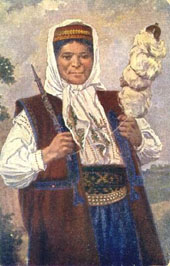 In the province of Molise in central
Italy there is a small Croatian enclave (about 4,500 people), living
today in several villages, inhabited in 15 villages in the 16th century
by the Croats fleeing before the Turks. They preserved their ethnic
identity and language even today.
In the province of Molise in central
Italy there is a small Croatian enclave (about 4,500 people), living
today in several villages, inhabited in 15 villages in the 16th century
by the Croats fleeing before the Turks. They preserved their ethnic
identity and language even today.
Since the 16th century a similar enclave has existed near Bratislava in Slovakia. The largest Croatian community of exiles dating from that period is in the area of Gradisce (Burgenland) in Austria and Hungary. One of the results of this forced migrations is that the most widespread surname in today's Hungary is Horvath, whose meaning is simply Croat. Also the family name Horvat is one of the most widespread in today's Slovenia. The surname Charvat (= Croat) in the present-day Czechia is a remaining of the presence of White Croats on this area since the Early Middle Ages. The family name Horwath and its variations is also very common in Austria (see the telephone book in Vienna). The most famous descendant of Gradisce Croats is without any doubt Joseph Haydn. It is interesting that King Ferdinand I (1515-1564) granted the Burgenland Croats in Austria the right to use Glagolitic Mass, see here.
In Slovenian part of Istria, near Italian border east of Trieste, there is the village of Hrvatini (literally - Croats). Also in Croatian part of Istria, north-east of Zminj, there is the village of Hrvatin. Several Istrian villages have names that are obviously related to those Croats who had to escape before the Turks from the region Lika and Krbava.
Additional information about centuries old Croatian emigration in Czechia and Slovakia can be obtained here:
Today there are several tens of thousands of Croats living in about fifty settlements in the region of Gradisce, i.e. Eisenstadt (about two thirds) and in Vienna (one third). There are 14 Croatian settlements left in Hungary and only four in Slovakia, among them Hrvatski Grob (Croatian Grave) near Bratislava. Specialists estimate that the overall number of Croatian settlements in these regions in the 16th century was as many as 200 to 300! In the 16th century in the area around Bratislava in Slovakia there were about sixty Croatian settlements. See Sanja Vulic, Bernardina Petrovic: Govor Hrvatskoga Groba u Slovackoj, Sekcija DHK i Hrvatkog PEN-a za proucavanje knjizevnosti u hrvatskom iseljenistvu, Zagreb 1999.
Soruce: Croatian glagolitic manuscripts outside of Croatia
If you visit Martin in Slovakia, you can see two leaves from a Croatian glagolitic book from 14th century. They are called Hlaholske listi Hlohovske (kept in Matica Slovenska), that were previously in the town of Hlohovec. I owe this information to dr. Ralph Cleminson, University of Portsmouth, Great Britain. We know of a church vistator to Zahorska Bystrica in 1561 who noted that the habitation is Croatian (populus Croaticus), and that it has its own Glagolitic priest (see Glas Koncila, 3. October 2004, p. 13).
Croatian refugees who had to escape from Croatia to Slovakia in front of the Turks were in great majority čakavians (čakavci) from Croatian littoral (Primorje), wherefrom they brought the Glagolitic liturgy. A church visitator, who was in Záhorska Bytrica in 1562, populated by Croatians, wrote that the Mass is served in Croatian language (lingua croatica). The Mass was Glagolitic, since the report from that visitation the Croatian priest was mentioned as Plebanus Glagolita. More about this can be seen in Dr. František Zagiba, Dejini slovenskej hudby, Bratislava 1944., pp 31 and 83. Záhorská Bystrica has no more Croatian population, due to assimilation. Since in the nearby village of Devinsko novo Selo the Croats still speak chakavian, as well as in the nearby village of Dubravka, we conclude that the Croats in Záhorska Bytrica were also chakavians (čakavci). See [Josip Andrić, pp. 166, 167].
Source: Croatian Music
Joseph Angster (1834-1918) was
born in Jagodnjak (Kacsfalu) in eastern Croatia (near Danube river),
famous church organ constructor. His organs can be found in many
churches in Austria, Hungary, Croatia, Czech Republic, Slovakia, Slovenia, Serbia, Montenegro, Poland,
in Rome -Italy, Romania and Ukraine. He participated in organ
construction for Cologne-castle, Notre-Dame church in Paris and for St.
Trinity church organ.
Many thanks to Mr. Darko Varga (from Bilje,
Baranja) for having contributed Angster's biography to this web.
Source: Bunjevci Croats in Backa
Josip Andrić (1894-1967) is a figure with a wide range of interests.
- In music he created about 700 songs, an opera Duzijanca for tamburitza Croatian Bunjevci in Backa, performed for the first time in Subotica in 1953,
- collected almost 2000 folk songs, he was conducting already at the age of 15.
- In literature, among the plenty of his books and brochures let us mention his history of Slovak music, the first ever written: Slovačka glasba, Hrvatsko-slovačko družtvo, 1944.
- And also the first grammar of the Slovak language, ever written outside of Slovakia: Slovnica Slovačkog jezika, HKD Sv. Jeronima Zagreb, 1942.
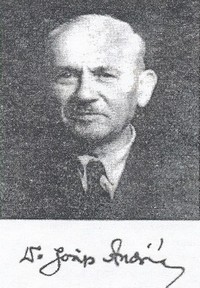
Dr. Josip Andrić, photo from Klasje naših ravni, Subotica, 2001.
In his weekly "Obitelj" (Family) Josip Andric wrote articles against Hitler already in the thirties of the 20th century. During WW2 he was arrested by Gestapo, but after three months of prison, upon intervention of the Slovak government, he had been released.
We owe him our first information about the glory of the Irish early Christian civilization, the fact that not only the British, but also the Francs received the Christian religion from them. He belonged to the Croatian Bunjevci and Šokci. During many years, and especially since 1991, they have been going through the process of almost complete ethnic and cultural extinction, with a rate and violence unknown in Europe after 1945. Only in the period between 1971 and 1991 (before the Greater Serbian aggression!) the number of the Bunjevc and Šokci Croats dropped from 140,000 to 74,000. It should be noted that, according to Jovan Erdeljanović, in 1930 in the region of the so called Vojvodina (the name imposed in 1945 during Communist Yugoslavia) there were 400,000 Croats, see [Sekulić, Bački Hrvati]. In this region the Croats had no any national minority rights until 2002.
The name of "Vojvodina" (Serbain name for "dukedom") has been imposed in 1945, although the Croats in Backa never had "vojvoda". In the period of 1930 - 1941 the Croats in Bačka were using the name of Bačka Hrvatska (information by Dr Ante Sekulić, see [Sekulić, Bački Hrvati]). It is interesting that near the town of Subotica there is a village called Hrvatski Majur (= Croatian estate).
Source: The Croatian Minority in Slovakia
By: Jasmina Kovacevic-Cavlovic
The Croatian Minority in Slovakia
Croatian-Slovak Ties
 The Bratislava Region |
The Croatian population could be divided into three territorial regions: the region of Zahoria to Skalice; the Danube river region - the environs of Bratislava, Cunovo, Jarovce and the region of the Little Carpathians. This territorial division in the above mentioned regions is highlighted by different dialects of the individual Croatian settlements in Slovakia. Croats in Devínska Nova Ves (Cr. Devinsko Novo Selo) are Cakavian speakers, and in Chorvátsky Grob (Cr. Hrvatski Grob) are Kajkavian-Ikavian speakers. For the first group it is believed that they came from the Croatian coastal regions and these others from the Kostajnica region. The Croatian Cakavian speakers settled west of Bratislava, along the Austrian-Slovakia border, and the Kajkavians east of it. The Croatian Cakavians brought to Slovakia with them the Glagolithic Mass from their homeland. The largest Croatian village is Devínska Nova Ves. Croatian is spoken in all the houses in the village, even though the language has come under the influence of the Slovak language. The population of Zahoria speaks a language similar to the language spoken among the people settled in the Burgenland region of Austria. A large possibility that the reason for this lies with the simultaneous arrival of Croats in some parts of the Burgenland or rather Slovakia. There are several references that the Croats in Zahorska Bystrica were there as early as 1529. In the years from 1561-1562, one Cannonical visitor wrote that the population of Zahorska Bistrica is Croatian with their own Glagolithic priest who celebrated Holy Mass in Croatian. It's no wonder that the Croats of Zahorska Bystrica have long preserved their national identity and the Croatian language.
At the end of the sixteenth and during the seventeenth centuries, the Croats were spread out so that specific Croatian settlements became Slovakized or Magyarized. What we want to emphasize now with the following historical piece is the arrival of Croats to Devín in the middle of the sixteenth century. Devín, especially Devínska Nova Ves was distinguished with a dense settling of Croats who came from but the immigration from Burgenland, Hungary and Moravia. The work of the Croatian priests had an influence in preserving the Croatian language, Croatian national consciousness and cultural practices: customs, traditional costumes, dances and songs.
It is important to mention one more settlement near Devín. Dubravka now a part of Bratislava was founded by the Croats in 1571 during the third stage of Croatian immigration. The Croatian identity was preserved, followed by the nurturing of the Croatian language transformed this place into a meeting place for most of the Croats in Slovakia. Today, however, the older generation of Dubravka speaks Croatian. The above could also be applied to the city of Skalice. The evidence for the existance of Croatian roots as well as something specific of this region is a document from 1569 in which Skalice was founded by an agreement of the majority of Croats, the builders and first inhabitants of this city.
The Danube region of Bratislava was also distinguished by the economic and social intersection of the Croatian settlers. With the elevation to an envious social status, the majority of the Croats succumb to assimilation. National consciousnees and custums slowly died out in the Slovak areas, and finally the Croatian language died. Of the Croatian settlements from the sixteenth century; Cunovo, Jarovce (Cr. Hrvatski Jandrof) and Rusovce (Cr. Rosvar) must be mentioned.
In the region beneath the Little Carpathians the settlements of Velika and Mala Senkvica, Chorvátsky and Slovensky Grob sprouted up. Together they show Croatian national consciousness in the above-mentioned settlements, is their centuries old existence. The sands of time have so that these Croatian settlements have become Slovakized preserving more or less the Croatian less or rather culture and tradition. The results of the research show that the Croatian population spread out very quickly in the sixteenth century and in the seventeenth and eighteenth centuries gradually assimilated. Opposite of our other co-nationals who immigrated to Austria, Italy or Hungary, the Croats of Slovakia did not have the means for strengthened national ties. Similar surroundings, especially religion and culture brought about a gradual merging with the Slovak people. However, this process of assimilation was particular. Indeed, the Croats in the cities quickly became Slovakized, Germanized of Magyarized. But in the villages they helped preserve the Slovak ethnos. If fact, in some areas, the Croats put pressure on the older German population and that importantly strengthened the Slovak ethnos.
In the eighteenth century, the majority of the Croatian settlements lose their national identity. Croatian is preserved the longest in Devínska Nova Ves and Chorvátsky Grob. Cunovo and Jarovce, which were attached to Czechoslovakia in 1945 from Hungarian patronage, have remained the most expressly Croatian villages. German and later Hungarian attempts at assimilation gave birth to a vigorous resistance of these Croatian villages and the strengthening of the national orientation of the Croats.
A general observation in the period of the 450 plus years of the existence of Croats in Slovakia, there were no fierce disagreements or fundamentally controversial situations. In fact, the Croatian population merged with the local population of Slovak origin into one, linguistically distinct, but a thoughtful kindred segment. This is how the historically congruent role of today's Slovak-Croat corpus was and today is an example of co-existence of the Slovak majority and the Croat minority.
Migratory movements in the eighteenth century brought Slovaks into Croatia. Overall, for similar reasons, the Slovak minority in their new homeland rose to a satisfactory position. Both minorities, the Croats in Slovakia and the Slovaks in Croatia, are a major factor in the centuries old Croatian-Slovak friendship. A Croatian-Slovak friendship society has existed as long as the young Republic of Slovakia. The initiative for its organization came a day after its creation [an independent Slovakia], and was founded on May 28, 1993. The following year in 1994, a Slovak-Croatian friendship society was founded. Both work and cooperatively with each other for the development of Croatian-Slovak and Slovak-Croatian friendship. Acquaintances state that the Croatian-Slovak friendship society is one of the most active in Croatia. Of its main activities, the fostering of Croatian-Slovak cooperation in the field of language and literature occupies a major place. Additionally, in the realization of local programs, they work with a number of governmental and non-governmental agencies, bodies, academic, artistic, economic, cultural and other agencies and media. From many and multi-leveled activities, literature evenings, honorably celebrate important anniversaries, academic and expert cooperation, publishing activities and the promotion of books, meetings and cooperation with other friendship societies.
From the fertile joint existence of the Slovak and Croatian peoples blossomed a series of joint ideas and activities. Of Bishops in the Zagreb Diocese, or Archdiocese, it is important to mention the Slovaks: Ivan Sipuski, Alexandar Alagovic, and Juraj Haulik. The Slovaks such as Stefan Moyses and Bogoslav Sulek assisted with the Croatian national revival. From the other side, the Croats Ivan Vitez (1) and Jannus Pannonius (2) contributed to the founding of the Academie Istropolitane in the fifteenth century.
It is also important to mention the especially fertile cultural and literary cooperation among the Slovaks and the Croatians during Ljudevit Stur's and the Illyrian movements. The relations between Ljudevit Stur and the head of the Illyrian movement, Ljudevit Gaj, gave particular distinction in this cooperation. Gaj, during his visit to Bratislava in 1833, promoted the well-known song Jos Hrvatska Ni Propala. Even though it was written in Vienna, this song was brought to life in Slovak-Croatian circles in Bratislava. The cooperation between Stur and Gaj continued through Stur's equal association if the Illyrian Movement and announcing literary supplements in Danica Ilirska. In the informing of Croatians with the Slovak national movement, Danica Ilirska has a noticeable role in the national rebirth of the Slovaks.
The traditionally strong ties between the Croatian and the Slovak peoples was followed by cooperation at a state level. The long suppressed cooperation during the Independent State of Croatia and the independent state of Slovakia, when Croatian-Slovak cultural ties were strengthened. The promoter of these ties was the Croatian-Slovak society founded in 1941 in Zagreb and the Slovak-Croatian society founded in 1942 in Bratislava. The then Croatian-Slovak cooperation assumed different manifestations: and was carried out on a wide range; from an exchange of artwork to the rotating organization of cultural weeks, and cooperation with higher schools, academies and libraries. Amicable political relations and cooperation were continued in 1945 in the framework of the new Communist countries. The similar positions of Croatia in Yugoslavia and the Slovaks in Czechoslovakia preordained their continued joint destinies. The collapse of Czechoslovakia and Yugoslavia allowed the new democratic countries further ties. Conditions were created for different international cooperation with the establishment of diplomatic ties between Croatia and Slovakia. Similar historical positions, and developing interests allowed the creating of bilateral agreements - such as agreements for culture, intellectual and academic cooperation in 1995. The above-mentioned agreement has clauses, which relate to the activities of the Croatian and Slovak minorities in both countries. Additionally in 1999, Croatia sent to Slovakia a Croatian drafted agreement for the bilateral protection of minorities. Also with the creation of independent countries, created an improved situation for both national minorities in both countries.
The Croats in Slovakia belong to a group that in the constitution of the Republic of Slovakia is listed as a national minority or ethnic group, in which according to the constitution, the rights of both groups are equalized. In reports according to national structure, Croats in Slovakia are listed as "others."
The members of the Croatian minority in Slovakia, some 3,000 Croats, today live in four Croatian villages: Devínska Nova Ves (Cr. Devinsko Novo Selo) Chorvátsky Grob (Cr. Hrvatski Grob) Cunovo and Jarovce (Cr. Hrvatski Jandrof). Official statistics from Slovakia in 1921 does not list the number of Croats in these places. Moreover, the official statistical report relies on the numerical results of the census from 1991. According to it, only 998 inhabitants of the above mentioned places declared themselves to be Croatian. The Croatian Cultural Alliance of Slovakia, founded in its first congress in May of 1990 in Jarovce, is an umbrella organization which represents Croatian cultural associations in Cunovo, Devínska Nova Ves, Chorvátsky Grob, and Jarovce, and since 1996 the Young Croatians club in Jarovce. The alliance has 1,200 members, it its activities however, up to 4,000 admirers of Croatian culture participate as well. Its work can be summarized as follows:
- participate in the realization of institutional and
financial conditions for the
renewal and development of Croatian culture in Slovakia;
- to promote uniting of nations and peoples and the
overcoming strict national tendencies
and prejudices;
- to support the creation of conditions for the free use of mother languages, promotion of Croatian culture, its transmission, preservation and development.
Representatives of the alliance and the free use of the Croatian language in the above-mentioned Croatian places. Another important activity is the care in the development of knowledge of the Croatian language. An important role in that direction is with language workshops for school children, which in 1998 was organized for a sixth time. The language workshops have influenced the beginning of extracurricular classes for Croatian in Chorvátsky Grob, Cunovo, Jarovce and partially in Devínska Nova Ves.
The activities of the Croatian Cultural Alliance are founded on the conclusions of the general congress of Croats in Slovakia, which is held every other year. Certain programs are taken from the agreement signed between the Minister of Culture for Slovakia and the Croatian Cultural Alliance. This previously mentioned agreement solidifies criteria and methodologies for the allocation of financial support. This way, the Alliance receives monetary resources for their program and projects for Croatian cultural performances. Currently, the most important project is the founding of a museum of Croatian culture in Devínska Nova Ves. In 1995, among the ethnic institutions in Slovakia, the Croatian Alliance had an allocated amount of 1,100,000 SKK of which 84.9% or 933,727 SKK (about 46,700 DEM). In terms of actual amount, among ten ethnic institutions it [The Croatian Cultural Alliance] was in sixth place after the Hungarians, Romis, Ruthenian-Ukrainian, Ruthenian revival and Carptho-Germans, but in front of the Czechs, Moravians, Bulgarians and Jews. From the previously mentioned financial support, the Alliance holds as an annual celebration, a festival of Croatian culture in Devínska Nova Ves.
In Devínska Nova Ves the Croatian cultural society, the Rosica choir and orchestra, and the Grbarcijeta folklore groups are active. A Croatian cultural society has been founded in Chorvátsky Grob, and the Chorvatanka choir is also active there. The Croatian cultural society and Cunovsko Jato are active in Cunovo. Jarovce is the headquarters for the Croatian cultural society and the Klub Mladi Hrvatov, and the group Melodija and a male choir are active here as well. The ripe activities of the Croats in Slovakia are supplemented with publishing activities. The magazines Novosielski Glas in Devínska Nova Ves and Magazin in Jarovce are published.
In this overview it is important to state how the rights of the citizens - members of the Croatian minority in Slovakia are in accordance with the important European standards for the protection of minority rights. A small number of our national minority have equal opportunities in education and participation in cultural, communal and economic life, state administration, and activities of a public nature via the majority population.
The active inclusion of the Croatian Cultural Alliance in the activities of the administration of state, especially in the fields of culture, partially in education, currently and gradually in the economic sphere, the Croatian minority is supported as an integral recognized portion of Slovak society. This loyalty does not prevent however, our co-nationals in the creating of specific requests as a national minority. Also with a constructive and well-meaning attitude our people have created a moral legitimacy in the solution to their question of status. In spite of five hundred years of assimilation, the actual and just expectations of the Croats in Slovakia that the Republic of Slovakia will recognize them as a national minority and in accordance with that treat them in statistical reports or rather with the practical realization of promised minority rights.
Source: Hrvatsko Slovo "Hrvatska Manjina u Slovackoj" Godina V./Broj 238 Zagreb, Petak, 12. Studenoga 1999.
Translated and edited by Marko Puljic
Original article in Croatian can be found at Hrvatsko Slovo's website .
Translator's Footnotes:
1. Ivan Vitez od Sredne (1405 Sredna near Krizevci - 1472 Esztergom, Hungary) a Croatian Humanist, and Archbishop of Eszetergom. Studied Law in Italy, where he also gained knowledge in the fields of Physics, Astronomy, and Alchemy. He participated in the education of Matthias Hunyadi (Corvinus) who later became King of Hungary and Croatia. He was promoted to the King's Chancellary and quickly became the Primas of Hungary. He was interested in natural knowledge and the study of it. He founded the academy and scriptorium in Budim and the university in Bratislava. As the instigator of a rebellion against Matthias Hunyadi from 1471-1472, he was stripped of his authority and his property. He fell ill shortly thereafter and died.
2. Jannus Pannonius (Ivan Cesmicki) nephew of Ivan Vitez and renowned Croatian Latinist. For a complete overview on him and his career, click here .
Related articles:
- Moravian Croats
- Croats in Bosnia and Herzegovina
- White Croats in parts of
Ukraine, Czechia, Slovakia and Poland
White Croats
Constantine Porphyrogenitus (905-959), a Byzantine emperor and writer, mentions the state bearing the name of White Croatia. His description shows that it occupied a wide region around its capital Krakow, in parts of Bohemia, Slovakia, and Poland. The state disappeared in 999. St. Adalbert (Vojtech, 10th century) was a descendant of the White Croats, son of the White-Croatian prince Slavnik. He was spreading Christianity, education and culture, and to this end founded the benedictine monastery in Brevnov in 993. Also St. Ivan Hrvat, who died in Tetin in Bohemia in 910, was a son of White-Croatian King Gostumil. It is interesting to add that according to some American documents from the beginning of this century there were about 100,000 immigrants to the USA born around Krakow (Poland) who declared themselves to be Bielo-Chorvats, i.e. White Croats by nationality. See US Senate-Reports on the Immigration commission, Dictionary of races or peoples, Washington DC, 1911, p. 40, 43, 105....
The name of the Croats is met in many places throughout Ukrainian soil. It is contained in Ukrainian written documents since the 2nd century until the end of the 10th century. The famous Ukrainian chronicler Nestor from Kyiv (in his "Povest vremennyh let", 1113) mentioned also the White Croats inhabiting early-medieval Old-Ukrainian empire, known as the Kyiv Rus'. According to a very old legend, one of the three brothers who founded the Ukrainian capital Kyiv was Horiv, whose name might be at least hypothetically related to the Croatian name: Horvat. See [Hrvatska/Ukrajina], p. 9, and [Pascenko], p. 105. Even today some of the Ukrainian citizens say for themselves to be the White Croats. There are many proofs that the Croats once lived in common with Ukrainian and Slovak people: their language (very widespread ikavian dialects in Croatia and Slovakia, ikavian language in Ukraine), legends, customs, many common toponyms etc.
There are numerous names of villages, hills and rivers in Slovakia, Czechia (especially in Moravia), Poland and Ukraine, which have their obvious equivalents in Croatia and Bosnia - Herzegovina. Many of them are indeed surprising:
Source: Croatian sports
Croatian team won the 2005 Davis Cup in the final match with Slovakia in Bratislava. This is one of the greatest achievements in the history of Croatian sport. Members of the team were
- Ivan Ljubicic,
- Mario Ancic,
- Ivan Karlovic, and
- Goran Ivanisevic.
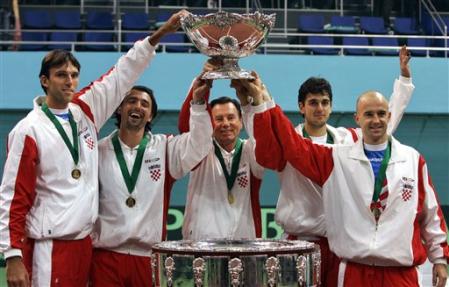
Nikola Pilic, leader of the team, thus became the first captain in the history of Davis cup to win the trophy for different nations (he led Germany to Davis Cup titles in 1988, 1989 and 1993).
Miro Gavran
Since 2003, the Jan Palarik Theatre from Trnava, Slovakia has organised a theatre festival that is unique in Europe, at which only the dramas and comedies of the Croatian author, Miro Gavran, are performed.
GAVRANFEST 2009 in Trnava Slovakia February 23 - 27, 2009
Miro Gavran's plays were translated into more than 30 languages
Miro Gavran 3 premieres in 3 countries in 2 weeks. Latvia, Slovakia and Czech R.
Source: King of Dolls
Juraj Cvecko, president of the Croatian cultural union in Slovakia, donated a doll from Hrvatski Grob, 1995.
Vladimir Bubrin & Vinko Grubisic: The Glory and Fame, Croatian Renaissance Reader, NY 2015
Vladimir Bubrin is of the Slovak origin.
My gratitude goes to professor Zvonko Bencic, University of Zagreb, for his impetus to create this web page.
Croatia - Japan Croatia - South America
Croatia - its History, Culture and Science
